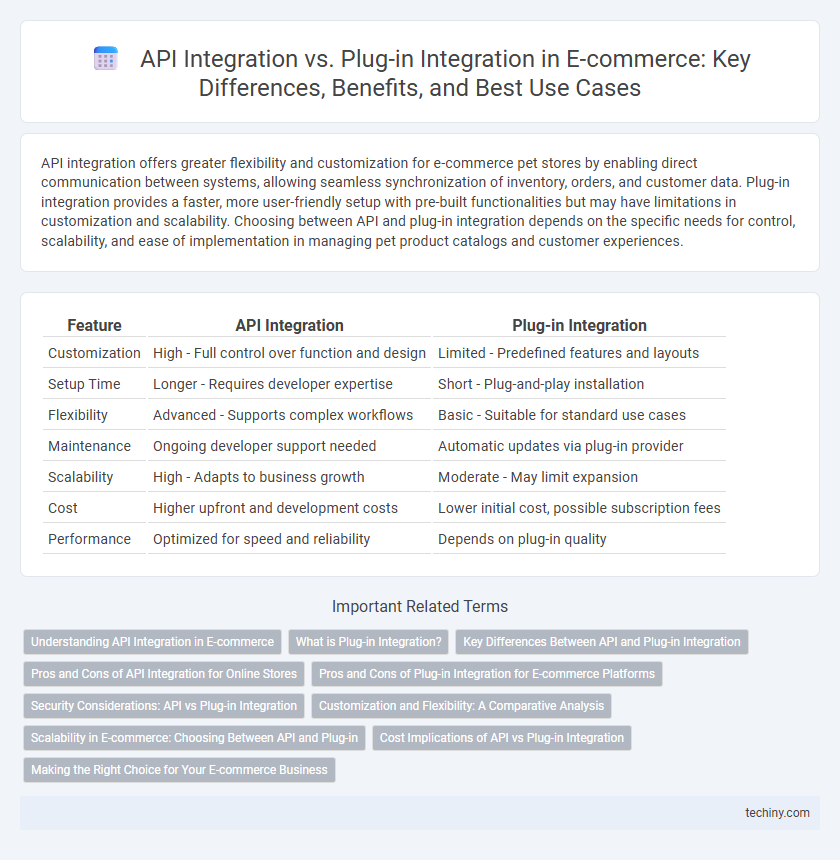API integration offers greater flexibility and customization for e-commerce pet stores by enabling direct communication between systems, allowing seamless synchronization of inventory, orders, and customer data. Plug-in integration provides a faster, more user-friendly setup with pre-built functionalities but may have limitations in customization and scalability. Choosing between API and plug-in integration depends on the specific needs for control, scalability, and ease of implementation in managing pet product catalogs and customer experiences.
Table of Comparison
| Feature | API Integration | Plug-in Integration |
|---|---|---|
| Customization | High - Full control over function and design | Limited - Predefined features and layouts |
| Setup Time | Longer - Requires developer expertise | Short - Plug-and-play installation |
| Flexibility | Advanced - Supports complex workflows | Basic - Suitable for standard use cases |
| Maintenance | Ongoing developer support needed | Automatic updates via plug-in provider |
| Scalability | High - Adapts to business growth | Moderate - May limit expansion |
| Cost | Higher upfront and development costs | Lower initial cost, possible subscription fees |
| Performance | Optimized for speed and reliability | Depends on plug-in quality |
Understanding API Integration in E-commerce
API integration in e-commerce enables seamless communication between different software systems, allowing online stores to connect directly with payment gateways, inventory management, and shipping services. This method provides greater customization and flexibility compared to plug-in integration, as APIs allow data exchange in real-time and support complex workflows tailored to specific business needs. Implementing robust API integration enhances operational efficiency by automating processes and improving the accuracy of order processing and customer data management.
What is Plug-in Integration?
Plug-in integration involves embedding pre-built software components directly into e-commerce platforms, enabling seamless feature enhancements without extensive coding. These plug-ins facilitate quick connectivity to third-party services such as payment gateways, inventory management, or marketing tools, optimizing operational workflows. Leveraging plug-in integration accelerates deployment time and reduces technical complexity, enhancing scalability for online stores.
Key Differences Between API and Plug-in Integration
API integration enables seamless data exchange between e-commerce platforms by directly connecting applications through standardized protocols and allowing customized workflows. Plug-in integration offers pre-built functionalities designed for easy installation and limited customization, typically enhancing specific features within an e-commerce system. The key difference lies in API's flexibility and scalability for complex, tailored solutions versus the plug-in's simplicity and ease of use for quick feature additions.
Pros and Cons of API Integration for Online Stores
API integration offers online stores enhanced flexibility and customization by allowing direct communication between different software systems, enabling tailored workflows and unique functionality. However, it requires higher technical expertise and longer development time compared to plug-in integration, potentially increasing initial costs and complexity for store owners. Despite these challenges, API integration provides scalable solutions and better control over data management, essential for businesses aiming to optimize their e-commerce operations and improve customer experience.
Pros and Cons of Plug-in Integration for E-commerce Platforms
Plug-in integration for e-commerce platforms offers ease of installation and instant access to pre-built features, reducing development time and technical expertise required. However, plug-ins may introduce compatibility issues with existing systems, limit customization options, and rely heavily on third-party updates for security and functionality. Choosing plug-in integration can streamline platform enhancement but necessitates careful evaluation of vendor reliability and ongoing maintenance impact.
Security Considerations: API vs Plug-in Integration
API integration offers enhanced security by allowing controlled, encrypted data exchanges directly between systems, minimizing vulnerabilities often exploited in third-party plug-ins. Plug-in integrations may introduce security risks due to reliance on external codebases that can contain vulnerabilities or lack regular updates. Secure API authentication protocols such as OAuth and tokenization further strengthen protection against unauthorized access compared to typical plug-in models.
Customization and Flexibility: A Comparative Analysis
API integration offers unparalleled customization and flexibility, allowing e-commerce platforms to tailor specific functionalities and workflows to unique business needs through direct code access. Plug-in integration provides quicker implementation with predefined features but often limits extensive customization, restricting adaptability to evolving requirements. Choosing between API and plug-in integration depends on the priority of scalable customization versus ease of deployment for e-commerce operations.
Scalability in E-commerce: Choosing Between API and Plug-in
API integration offers greater scalability in e-commerce by enabling seamless customization and the ability to connect multiple systems without limitations inherent to plug-ins. Plug-in integration may simplify initial setup but often restricts growth due to dependency on specific platforms and limited flexibility. Choosing API integration supports long-term expansion through adaptable, robust connections tailored to evolving business needs.
Cost Implications of API vs Plug-in Integration
API integration often involves higher upfront costs due to custom development and ongoing maintenance requirements, while plug-in integration typically offers a lower initial investment with faster deployment. API integration provides greater flexibility and scalability, potentially reducing long-term expenses as business needs evolve, whereas plug-ins may incur costs linked to compatibility issues and limited customization. Businesses must evaluate total cost of ownership, including development, updates, and support, to determine the most cost-effective integration approach for their e-commerce platform.
Making the Right Choice for Your E-commerce Business
API integration offers customizable, scalable solutions that enable seamless data exchange between your e-commerce platform and third-party services, ideal for businesses seeking tailored workflows and advanced functionalities. Plug-in integration provides quick, user-friendly installation with pre-built features, perfect for small to medium-sized e-commerce stores aiming for rapid deployment and simplified maintenance. Evaluating your business needs, technical resources, and desired flexibility will determine whether API or plug-in integration maximizes efficiency, enhances customer experience, and supports growth.
API Integration vs Plug-in Integration Infographic

 techiny.com
techiny.com